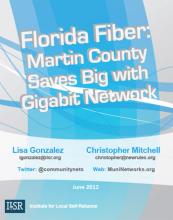
Fast, affordable Internet access for all.

In June, the city council of Greenacres, Florida, voted to invest $42,550 to connect to Palm Beach County's fiber-optic network. Greenacres joins a growing list of Palm Beach County municipalities who have data-transmission agreements with the County. Other towns include Palm Beach Gardens, Jupiter, Juno Beach, West Palm Beach, Delray Beach and Riviera Beach.
Willie Howard of the Palm Beach Post covered the Greenacres story earlier this month:
Instead of paying AT&T and Comcast $33,360 annually for transmission lines, the city will pay Palm Beach County $8,400 annually.
"It's basically cost sharing as opposed to revenue generating," said Mike Butler, director of network services for Palm Beach County. "We're not in it to make money."
Thomas Hughes, Finance Director of Greenacres, estimates the savings to the City will amount to $124,800 over five years.
In addition to saving money, Greenacres will have the advantage of increased speed. Currently, AT&T and Comcast provide a 1.5 Mbps connections. The new arrangement will provide 10 Mbps from the County - six times faster at a little more than one third the cost. The City can also feel good about keeping the dollars local and will avoid the uncertainty in dealing with remote and giant AT&T or Comcast.
Palm Beach County sits just south of Martin County, where a municipal network saves the County and school district significant dollars for connectivity. You can download our recent case study on Martin County, Florida Fiber: How Martin County Saves Big with Gigabit Network, to learn more about that network.
Arlington County, Virginia is taking advantage of a series of planned projects to create their own fiber optic network, ConnectArlington. The County is moving into phase II of its three part plan to improve connectivity with a publicly owned fiber network.
Some creative thinking and inter-agency collaboration seem to be the keys to success in Arlington. Both the County and the Arlington Public Schools will own the new asset. Additionally, the network will improve the County Public Safety network. Back in March, Tanya Roscola reported on the planing and benefits of the ConnectArlington in Government Technology.
Arlington County's cable franchise agreement with Comcast is up for renewal in 2013. As part of that agreement, the schools and county facilities have been connected to each other at no cost to the County. Even though there are still active negotiations, the ConnectArlington website notes that the outcome is uncertain. The County does not know if the new agreement will include the same arrangement. Local leaders are not waiting to find out, citing need in the community and recent opportunities that reduce installation costs.
Other communities, from Palo Alto in California to Martin County in Florida, have found Comcast pushing unreasonable prices for services in franchise negotiations. Smart communities have invested in their own networks rather than continue depending on Comcast.
Like schools all around the country, Arlington increasingly relies on high-capacity networks for day-to-day functions both in and out of the classroom. Digital textbooks, tablets, and online testing enhance the educational adventure, but require more and more bandwidth and connectivity. From the article:
Through ConnectArlington, Arlington Public Schools will be able to take advantage of Internet2 for distance learning. At no cost, students will be able to communicate with teachers and access electronic textbooks and online courses from wireless hot spots.

Riverside, California was just named the Intelligent Community of the Year 2012 by the Intelligent Communities Forum. It is only the fourth U.S. city to win in the 14-year history of the award. Among its top qualifications are a publicly owned fiber optic network linking public buildings (eliminating the need for any leased lines) and a free Wi-Fi network that aids an impressive digital inclusion approach.
The path to the award began in 2005, when the City hired a full time CIO, Steve Reneker, and launched SmartRiverside as a way to attract technology companies. In addition to efforts to connect to California's reputation as a technology leader, the City invested in the basics. From a Government Technology article:
A year later, the City Council addressed physical infrastructure needs by approving Riverside Renaissance, a $2 billion effort to improve traffic flow; replace aging water, sewer and electric infrastructure; and expand and improve police, fire, parks, library and other community facilities.
“We’ve done a number of things that have changed Riverside to make us competitive,” said Mayor Ron Loveridge.
Part of being competitive was capitalizing on the City's existing fiber network ring, managed and maintained by the City Public Utility. The fiber network was originally focused on running the operational facilities for power and water but according to Reneker, via email:
...over the past 4 years, IT was able to work with our City Manager’s office and finance the construction of fiber to every City facility. So all telco lines have been eliminated and now all voice, data and video traverses the 1Gb network to City Hall. In addition, the City went live with City wide WiFi in May 2007, and the fiber was run to 6 tower locations to enable WiFi coverage city wide.
The fiber network provides the needed infrastucture to offer free Wifi all over the City. From the Intelligent Communities website:
We have brought you news about DC-Net before and have even highlighted the community network in our report, Breaking the Broadband Monopoly. Now we want to draw your attention to some videos they have produced.
Free WiFi hotspots all over town, secure indoor WiFi for government staff, and hundreds of miles of fiber throughout town are just a few of the advances DC-Net has made toward ubiquitous and reliable connectivity. DC-Net is a tremendous example of a publicly owned network providing the highest levels of performance for its subscribers.
DC-Net has released a video highlighting their advancements in DC and how their work has positively impacted the community.
The second video is from Don Johnson, Director of DC-Net, presenting some info on DC Community Access Network (DC-CAN) to a Ward 5 audience. DC-CAN is an initiative to bring broadband to the underserved areas in DC with middle-mile connections. From the DC-CAN website:
The DC Community Access Network (DC-CAN) will bring affordable, value-added broadband services to over 250 health, educational, public safety, and other community anchor institutions primarily in broadband underserved areas of the District. It also creates a high speed middle mile network for last mile service providers to deliver affordable broadband access to residents and businesses in underserved areas.
DC-CAN already has 67 miles of fiber laid as a backbone and four city MegaPOP sites are now connected to the 100G backbone. From Ciena, one of DC-Net's private sector partners:
With this new infrastructure in place, DC-Net has already connected 49 new Community Anchor Institutions to the network and upgraded 52 existing anchor sites. Community anchors include charter schools, health clinics and other health care providers, community-based training programs, after school and early childhood development programs, libraries, and public safety sites.
Another video from the Building Community Capacity through Broadband project (hosted by the University of Wisconsin Extension service) takes a look at how local governments use broadband and the importance of high capacity, reliable connections that they can actually afford.
This video is no longer available.Two hours northwest of the nation’s capital lies rural Allegany County, in western Maryland on the border with Pennsylvania. In the mid-1990s, before cable internet was even widely available, the county launched a successful wireless carrier network that would expand into an envied public model. In 1996, the State of Maryland offered financial assistance to wire public schools. They used a wireless solution due to the high costs of fiber-optic cables then. To raise funds and pool grant dollars from the Appalachian Regional Commission (ARC), the school partnered with fellow agencies Allegany County, Allegany County Library System, and the City of Cumberland. The new Allegany County Network (AllCoNet) placed its first wireless antenna atop the courthouse, the county’s highest point, and launched the network at a cost of $4.3 million.
The network that evolved into AllCoNet began with far more modest goals than restoring prosperity to the county. In 1996, the State of Maryland offered financial incentives to help wire public school buildings for fast Internet access. But connecting the public schools with fiber-optic cable would have been prohibitively expensive. As an alternative, Jeff Blank, the microcomputing and networking supervisor for Allegany County Public Schools, suggested a wireless network in which signals would be transmitted via microwave relays, traveling from one high point to another. Mounting the first antenna at the top of the Allegany County courthouse, one of Cumberland's high points, seemed only logical, and so began a common-sense venture in interagency cooperation. (ARC Magazine)
The early justification for such a network was rooted in the private sector avoidance of building in rural areas but also the pressing demand for economic growth and good broadband technology being just outside the nation’s major eastern cities. To eliminate the Digital Divide, AllCoNet looked to provide carrier class, affordable service to public entities like government and schools while upholding an open access model to let private companies serve the public at reasonable costs -- avoiding massive infrastructure debt.
Arizona Avenue, the Mid-City area and the city's office district will all be getting makeovers if the City Council approves two contracts that will connect 40 signalized intersections to City Hall's centralized traffic control system. The work represents the fourth phase in a five-phase effort to connect all of Santa Monica's intersections using fiber optic cables.
The program was selected for this award in the economic development category for the network's effectiveness in attracting technology companies to the city and supporting existing Santa Monica businesses with a leading edge broadband infrastructure, city officials said. Santa Monica City Net's model is being replicated by the cities of Burbank and Long Beach, and is in review by Chicago and Calgary.As we explained in Breaking the Broadband Monopoly, Santa Monica started with an I-Net on which they could not run commercial traffic and slowly built their own network that had no conditions on how it was used. In the past, this network has received the "Significant Achievement Award" from the Public Technology Institute (PTI). This press release recaps some details from their network:
The City created a telecommunications master plan and built a fiber optic network that connected 59 buildings used by the City, Santa Monica-Malibu Unified School District, and Santa Monica College. Savings realized by this project enabled the City to construct its own municipal fiber optic network, Santa Monica City Net, to support traffic cameras, security cameras, real-time parking advisory systems, a traffic signal synchronization system, and real-time mass transit signs. The City also leases dark fiber and lit services to local businesses for affordable broadband. The results of Santa Monica's advanced broadband initiative are a reduction in construction costs of new broadband service, an increase in purchasing power of connected local businesses, and a broadband market expansion for global Internet Service Providers that now offer service to small, medium and large commercial buildings.

In the process of knitting a baby blanket, a whole ball of yarn became tangled into this mess. . . .
. . . reminding me of the time, in the early eighties, when I was the second cable administrator appointed in the U.S., and found myself peering into a hole in the street filled with a similar looking mess—only made of copper wires, instead of yarn.